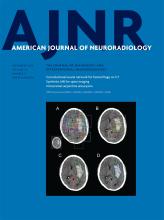Index by author
Raz, E.
- NeurointerventionYou have accessToward a Better Understanding of Dural Arteriovenous Fistula Angioarchitecture: Superselective Transvenous Embolization of a Sigmoid Common Arterial CollectorM. Shapiro, E. Raz, M. Litao, T. Becske, H. Riina and P.K. NelsonAmerican Journal of Neuroradiology September 2018, 39 (9) 1682-1688; DOI: https://doi.org/10.3174/ajnr.A5740
Rezaii, P.
- FELLOWS' JOURNAL CLUBAdult BrainYou have accessEvaluation of Thick-Slab Overlapping MIP Images of Contrast-Enhanced 3D T1-Weighted CUBE for Detection of Intracranial Metastases: A Pilot Study for Comparison of Lesion Detection, Interpretation Time, and Sensitivity with Nonoverlapping CUBE MIP, CUBE, and Inversion-Recovery-Prepared Fast-Spoiled Gradient Recalled Brain VolumeB.C. Yoon, A.F. Saad, P. Rezaii, M. Wintermark, G. Zaharchuk and M. IvAmerican Journal of Neuroradiology September 2018, 39 (9) 1635-1642; DOI: https://doi.org/10.3174/ajnr.A5747
The authors performed a retrospective review of 48 patients with cerebral metastases from June 2016 to October 2017. Brain MRIs included gadolinium-enhanced T1-weighted IR-FSPGR-BRAVO and CUBE, with subsequent generation of nonoverlapping CUBE MIP and overlapping CUBE MIP. Two blinded radiologists identified the total number and location of metastases on each image type. This study suggests that the use of overlapping CUBE MIP or nonoverlapping CUBE MIP for the detection of brain metastases can reduce interpretation time without sacrificing sensitivity, though the contrast-to-noise ratio of lesions is highest for overlapping CUBE MIP.
Riddehough, A.
- Patient SafetyYou have accessGadolinium Deposition in Deep Brain Structures: Relationship with Dose and Ionization of Linear Gadolinium-Based Contrast AgentsH. Kang, M. Hii, M. Le, R. Tam, A. Riddehough, A. Traboulsee, S. Kolind, M.S. Freedman and D.K.B. LiAmerican Journal of Neuroradiology September 2018, 39 (9) 1597-1603; DOI: https://doi.org/10.3174/ajnr.A5751
Riedel, C.H.
- Adult BrainYou have accessVessel Wall Enhancement in Unruptured Intracranial Aneurysms: An Indicator for Higher Risk of Rupture? High-Resolution MR Imaging and Correlated Histologic FindingsN. Larsen, C. von der Brelie, D. Trick, C.H. Riedel, T. Lindner, J. Madjidyar, O. Jansen, M. Synowitz and C. FlühAmerican Journal of Neuroradiology September 2018, 39 (9) 1617-1621; DOI: https://doi.org/10.3174/ajnr.A5731
Riina, H.
- NeurointerventionYou have accessToward a Better Understanding of Dural Arteriovenous Fistula Angioarchitecture: Superselective Transvenous Embolization of a Sigmoid Common Arterial CollectorM. Shapiro, E. Raz, M. Litao, T. Becske, H. Riina and P.K. NelsonAmerican Journal of Neuroradiology September 2018, 39 (9) 1682-1688; DOI: https://doi.org/10.3174/ajnr.A5740
Robertson, A.
- FELLOWS' JOURNAL CLUBFunctionalYou have accessBreath-Hold Blood Oxygen Level–Dependent MRI: A Tool for the Assessment of Cerebrovascular Reserve in Children with Moyamoya DiseaseN. Dlamini, P. Shah-Basak, J. Leung, F. Kirkham, M. Shroff, A. Kassner, A. Robertson, P. Dirks, R. Westmacott, G. deVeber and W. LoganAmerican Journal of Neuroradiology September 2018, 39 (9) 1717-1723; DOI: https://doi.org/10.3174/ajnr.A5739
Twenty children (30 imaging sessions, 60 MR scans) with Moyamoya disease underwent dual breath-hold hypercapnic challenge blood oxygen level–dependent MR imaging of cerebrovascular reactivity studies in the same MR imaging session. Within-day, within-subject repeatability of cerebrovascular reactivity estimates, derived from the blood oxygen level–dependent signal, was computed. Breath-hold hypercapnic challenge blood oxygen level–dependent MR imaging is a repeatable technique for the assessment of cerebrovascular reactivity in children with Moyamoya disease and is reliably interpretable for use in clinical practice.
Rodrigues Goncalves, M.R.
- You have accessMR Imaging Features of Adult-Onset Neuronal Intranuclear Inclusion Disease May Be Indistinguishable from Fragile X–Associated Tremor/Ataxia SyndromeI.G. Padilha, R.H. Nunes, F.A. Scortegagna, J.L. Pedroso, V.H. Marussi, M.R. Rodrigues Gonçalves, O.G.P. Barsottini and A.J. da RochaAmerican Journal of Neuroradiology September 2018, 39 (9) E100-E101; DOI: https://doi.org/10.3174/ajnr.A5729








